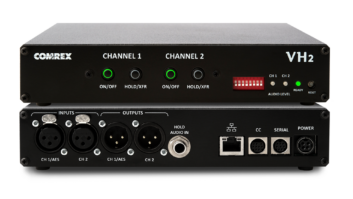Audacy promised it would “embrace innovation” as it emerges from bankruptcy. A recent move in the Denver radio market would seem to check that box.
The media company launched its first FM station with Super Hi-Fi and its cloud-based Program Director Radio Operating System. The company called it a “cloud-first technology” and said it provides a combination of “AI tools and transmitter-based reception to a single device via an audio stream.”
FM translator K276FM rebroadcasts an HD2 signal from another Audacy station in the market. The translator is called Front Range Country 103.1 in Denver. Even though voices on the station are human, the companies say this is the first commercial station in the U.S. to use full AI technologies and tools.
The Super Hi-Fi suite includes AI-driven production, scheduling, voice track mastering and audio preparation. Its Program Director platform also manages music curation, content, ads, scheduling voice tracking and station playout tasks.

“This couldn’t be a better time to take a first step and bring in cutting-edge technology,” Clay Walker, VP of content operations at Audacy, said.
“We’ve been trying to find a place to experiment and roll out this new technology, and Denver was the perfect fit.”
Audacy is the second largest radio broadcaster in the United States. Walker said the company hopes to enable better content and engaging programming by giving back more time to staff.
“By not scheduling music and imaging, and instead leaning into machine learning, we can enhance the station content and make better radio.”
“Additive to the brand”
Audacy programmers set up the “guidelines and guardrails,” with programming rotations and rules for the radio station, and then let Super Hi-Fi take over.
“It’s really additive to the brand while at the same time freeing up staff to do the other stuff that matters, from building new promotions, coaching talent and writing new imaging,” Walker said. “We want to optimize human-led programming and production efforts to better serve station listeners.”
The technology allows the broadcaster to move the broadcast infrastructure mostly to the cloud, including programming, assembly and playout, Walker said.
The launch included a move to a “fully transmitter-based playout structure, underpinned by the Orban Optimod 5950 Super Hi-Fi Edition,” according to the Audacy press release.
“This way we are shrinking the broadcast equipment footprint for innovation,” it continued. “The combination of cloud-based AI radio tools, along with transmitter-based reception and playout, demonstrates how the next step in radio operations will be simpler and easier to manage, with significantly lower costs across the operations chain.”
Walker said Super Hi-Fi’s Composer program reads the brand manager’s instructions and interprets through AI modeling from historical radio data.
“The system understands how to intelligently sequence songs in a specific, interesting order based on the basic parameters our brand managers initially establish in the Super Hi-Fi platform. Then this sequence of songs and imaging is passed over to ‘Magic Stitch,’ another of their tools, which assembles everything in order and handles the timing of transitions. The stop sets and songs all of it stitched together with the song fades.
“Unlike a typical playout system, Super Hi-Fi’s Magic Stitch tool makes interesting segues that are truly specific to each transition. Did the jock talk too long? Do you want to have a longer dry sweeper over a short intro? Super Hi-Fi automatically creates instrumental versions of songs for extended song intros. It makes for a very interesting listener experience.”
The Super Hi-Fi-composed audio stream is pushed through cloud-based digital signal processing before it even arrives at the broadcast plant, he said. What Audacy receives is a “high-quality industrial-grade redundant HLS+ stream,” which is then run into the Orban processing box for final FM audio processing.
“The firmware in the (Orban) 5950 leverages HLS+ to ‘stitch’ together the audio streams, similar to how Netflix does it,” Walker said.
It provides a more robust listener experience. “If there is a problem with the internet connection, the radio station doesn’t go off the air. It’s a much safer way to send audio verses a single linear stream.”
The Super Hi-Fi system won’t be affected by error correction or bit-rate reduction when the internet stream slows down, Walker said, which allows the HLS+ stream to stay true to the absolute highest bit rate it can pass down. “That gives us the highest fidelity possible.”
Until EAS can be virtualized, Audacy is using the Orban 5950 as a “patch point” for emergency alerts, Walker added.
Average listeners probably haven’t noticed a drastic change in the programming of the radio station. “The goal was for it to be as good as it was before, if not marginally better overall,” he said.
A need for change

Zack Zalon, the CEO of Super Hi-Fi, said traditional radio tools are powerful and flexible but also very old.
“The reality is that the business model has changed dramatically. Businesses need to operate differently. They need more innovation. They need to reorganize themselves and they need to run more efficiently.”
He said Super Hi-Fi believes broadcast radio can be “digital first,” driven by cloud technology delivered directly to transmitter sites using more modern infrastructure.
Zalon said part of that strategy is using AI to create efficiencies around things that take the time of humans, tasks like music scheduling and running an automation system.
“It’s so much more efficient. It is 80 percent less time spent updating and maintaining your radio station. Staff can now focus on building better listening experiences,” Zalon said. He called it “a broadcast ecosystem with less complexity.”
The Orban 5950 is an important part of this, he said. The processor can handle the HLS+ streaming technology and do the audio processing, PPM encoding and metadata management.
That all-in-one appliance replaces other equipment and the need for dedicated PCs, he said.
The partnership of Audacy and Super Hi-Fi is not new. They announced earlier last year that five of Audacy’s HD2 stations had transitioned to the Program Director Operating System. Audacy’s 700 digital Exclusive Stations also now support Super Hi-Fi’s HLS+ streaming technology.
[Read More Radio World Stories About Artificial Intelligence]







